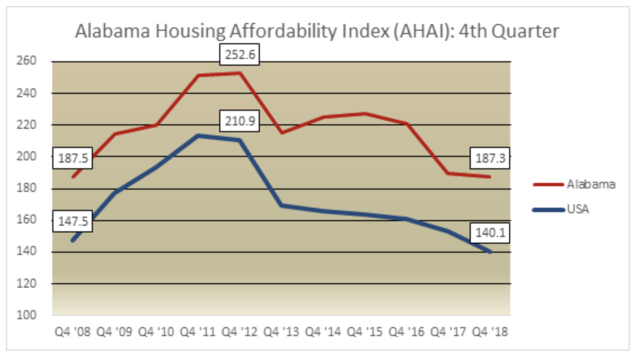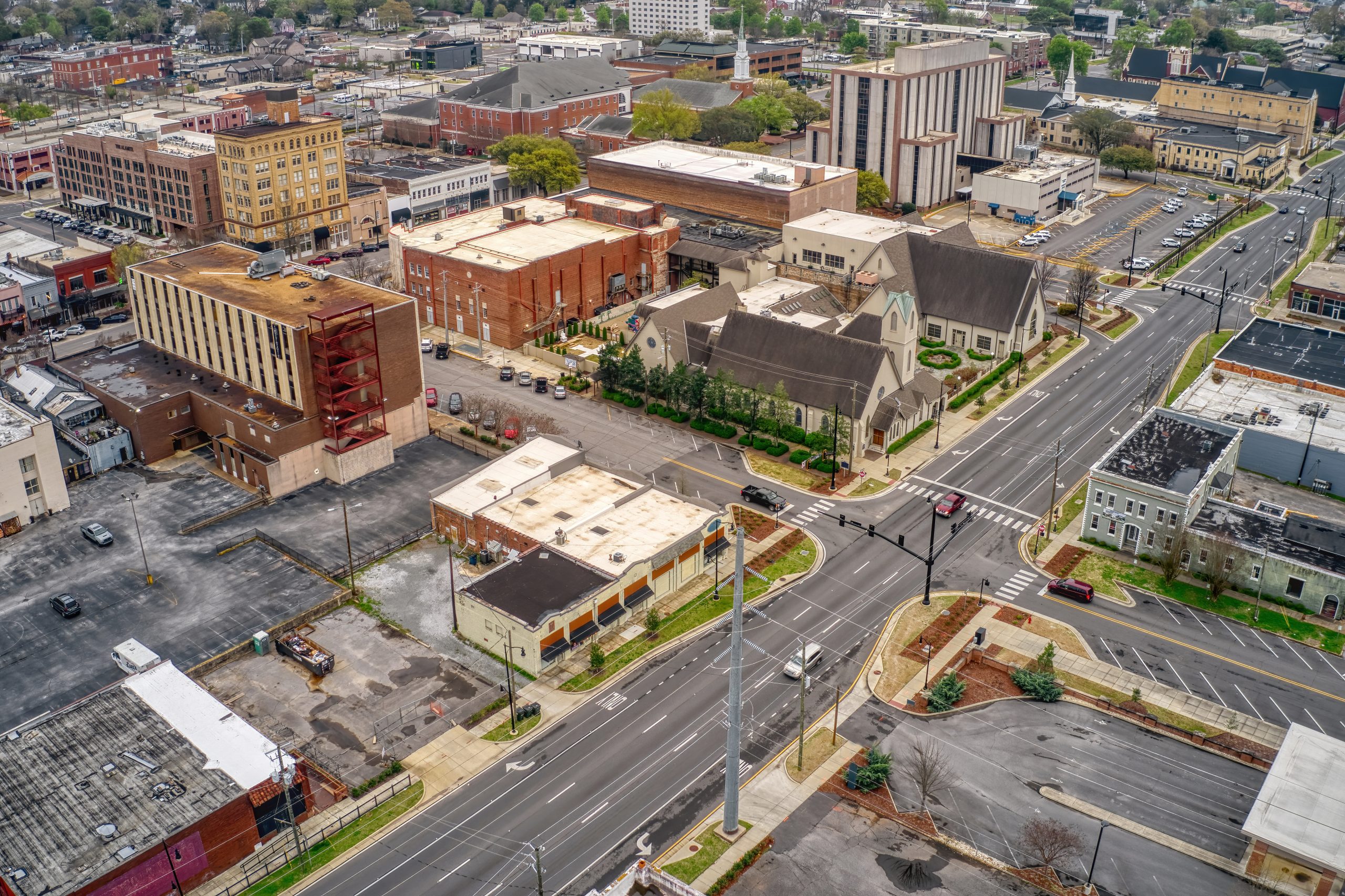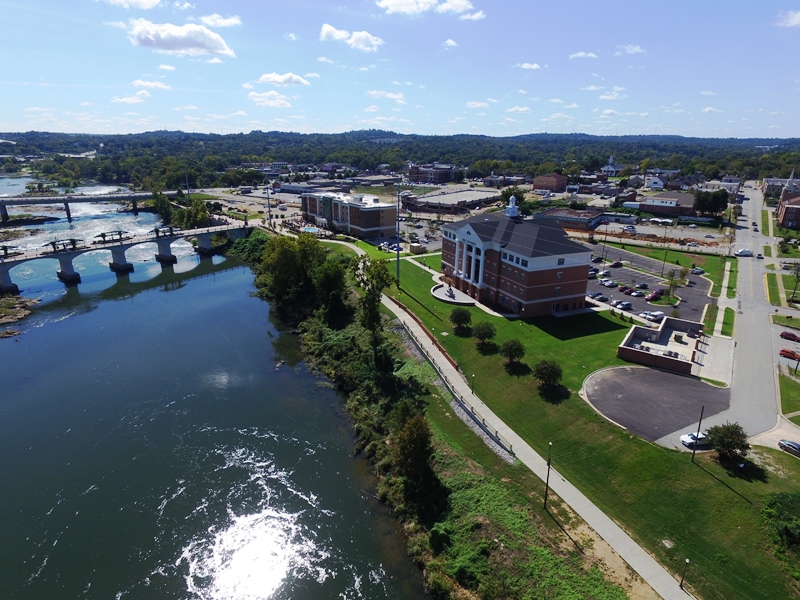Real estate markets across Alabama had a strong 2018. The fourth quarter of 2018 saw an increase in home affordability, increasing to 187.3. Although interest rates rose from 4.57% in the third quarter to 4.87% in the fourth quarter, the statewide median sales price decreased 5.31% during that period. Moreover, the rising interest rates and home price appreciation was offset by the increase in median family income (MFI).
The Alabama Housing Affordability Index (AHAI) for the fourth quarter of 2018 increased 1.88 percent from the third quarter score of 183.8 to 187.3. This means that a family earning Alabama’s median family income of $60,200 has a little more than 1.87 times the required income to qualify for a loan to buy the statewide median-price home, which was $156,503 during the fourth quarter of 2018. The National Housing Affordability Index for the fourth quarter of 2018 was calculated at 140.1. A family earning the nationwide median family income of $71,900 had a little more than 1.40 times the necessary income to buy the nationwide median-priced home, which was $255,333. Even though the median family income nationwide is 19.4 percent greater than the median family income in Alabama, Alabama continues to be a more affordable market because our real estate prices are significantly lower than national averages.

To read the Alabama Center for Real Estate’s entire Q4 2018 Alabama Housing Affordability Index, with a detailed explanation of the AHAI’s methodology, click here.
Alabama’s Most Affordable Metropolitan Areas
The table shows Alabama’s most affordable metropolitan areas. There are 12 of these areas in the state, according to the Center for Business and Economic Research (CBER) at the University of Alabama. Alabama’s metropolitan areas are Anniston-Oxford-Jacksonville, Auburn-Opelika, Birmingham-Hoover, Daphne-Fairhope-Foley, Decatur, Dothan, Florence-Muscle Shoals, Gadsden, Huntsville, Mobile, Montgomery and Tuscaloosa.
The smallest metro area in terms of population is Gadsden, with 102,564 residents in the metro area in 2016. Gadsden’s population is slowly declining according to Census data, and CBER projects that the Gadsden metro-area population will drop by 3.7 percent with 100,612 projected residents in 2030.
The largest is Birmingham-Hoover, with 1,147,417 residents in the seven-county metro area. CBER projects a 7.3 percent increase in population to 1,210,100 residents by 2030.
The fastest-growing metro area in the state is Daphne-Fairhope-Foley. There were 208,563 residents in the metro area during 2016. CBER projects that the metro population will increase 43.6 percent from 2010 to reach 261,777 in 2030.
The most affordable metro areas in Alabama, ranked by ACRE’s Alabama Housing Affordability Index, are Gadsden (228.1), Florence-Muscle Shoals (215.1), Decatur (206.2), Anniston-Oxford (203.7) and Mobile (201.0). One fact that stands out is that the two metro areas with the highest median family incomes, Birmingham-Hoover with $71,000 and Huntsville with $78,700, did not make the top five most affordable metro areas. This is due, not surprisingly, to relatively high median sales prices in each area: $195,775 in Birmingham-Hoover and $215,617 in Huntsville.
The least affordable metro areas are Auburn-Opelika (134.6) and Daphne-Fairhope-Foley (144.6). Both areas have median family incomes significantly above the state average, but are also home to median sales prices in the lower to mid 200s range: $247,178 for Auburn-Opelika and $238,753 for Daphne-Fairhope-Foley. It should be noted, however, that the median price in Daphne-Fairhope-Foley includes condominium sales, many of which are of the ultra-luxury, beachfront type.

Alabama’s Most Affordable Non-Metropolitan Areas
The most affordable non-metropolitan areas in Alabama are Monroe County (345.4), Marshall County (184.4), Walker County (178.3), Talladega County (160.0) and Cullman County (156.7).
At $52,700, Marshall County has the highest median family income of Alabama’s non-metro areas, and it increased 22.6 percent from 2017. This can be explained Marshall County’s proximity to the Huntsville metro area and overall job growth in north Alabama. Huntsville-area real estate, again, is somewhat expensive, so it is not surprising that many people buy houses in nearby areas, such as Marshall County, and commute to Huntsville for work.
The least affordable non-metropolitan area is Tallapoosa County, with an AHAI score of 131.2. Tallapoosa and Auburn-Opelika are the only two areas to score below the national average. However, Tallapoosa County’s median sales price of $197,500 includes a significant number of expensive waterfront homes on Lake Martin.






